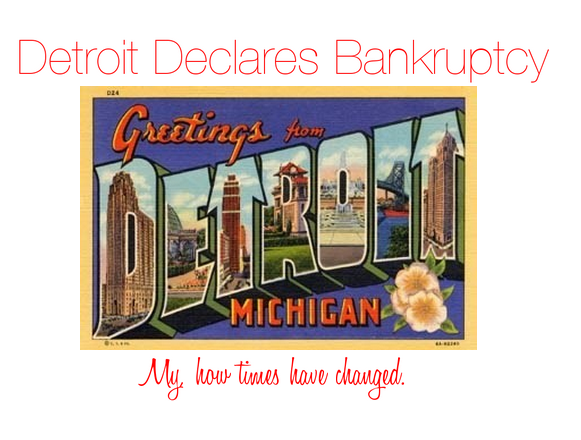The struggle is real of the city of Detroit.
Years of white flight, out-sourcing and declining industries, decreasing taxes and a financial crisis have left Detroit filling for Chapter 9 (municipal) bankruptcy. According to The Wall Street Journal, Chapter 9 bankruptcy gives municipalities the ability to tackle their debt problems, something they might not have been able to do before hand. Despite declaring bankruptcy, the city is still open for business. Public services will still occur; however, taxes will most likely increase (a major problem for a small population with low incomes) and there may be issues with pensions.
How did this happen?
Well as I mentioned, it was a perfect storm; however, this storm didn't occur out of the blue, it was a long time coming. During the 1950s and 1960s, racial tensions grew high in Detroit, causing many of the white as well as wealthy citizens to "flee" to the suburbs. For some reason, Detroit really hasn't recovered from this, like many other cities in the U.S. has. Known as the Motor-City for it's booming automotive and transportation industry, this is where Detroit made its money. When companies began to leave the U.S. for cheaper work south of the border (as well as in Asia), this left a city dependent on the industry in quite the lurch. Finally, with the loss of jobs and the "white flight", the tax bracket of Detroit greatly decreased, and when paired with the financial crisis, it would be hard for any city to recover.
Despite all of this, I'm not giving up hope for the Motor City. This filing of bankruptcy will be an opportunity for the government to restructure and just reminder to all the skeptics out there, New York almost declared bankruptcy in the 1970s, and look at it now. I won't ask if, but I will ask how long do you think it will take for Detroit to bounce back?
Years of white flight, out-sourcing and declining industries, decreasing taxes and a financial crisis have left Detroit filling for Chapter 9 (municipal) bankruptcy. According to The Wall Street Journal, Chapter 9 bankruptcy gives municipalities the ability to tackle their debt problems, something they might not have been able to do before hand. Despite declaring bankruptcy, the city is still open for business. Public services will still occur; however, taxes will most likely increase (a major problem for a small population with low incomes) and there may be issues with pensions.
How did this happen?
Well as I mentioned, it was a perfect storm; however, this storm didn't occur out of the blue, it was a long time coming. During the 1950s and 1960s, racial tensions grew high in Detroit, causing many of the white as well as wealthy citizens to "flee" to the suburbs. For some reason, Detroit really hasn't recovered from this, like many other cities in the U.S. has. Known as the Motor-City for it's booming automotive and transportation industry, this is where Detroit made its money. When companies began to leave the U.S. for cheaper work south of the border (as well as in Asia), this left a city dependent on the industry in quite the lurch. Finally, with the loss of jobs and the "white flight", the tax bracket of Detroit greatly decreased, and when paired with the financial crisis, it would be hard for any city to recover.
Despite all of this, I'm not giving up hope for the Motor City. This filing of bankruptcy will be an opportunity for the government to restructure and just reminder to all the skeptics out there, New York almost declared bankruptcy in the 1970s, and look at it now. I won't ask if, but I will ask how long do you think it will take for Detroit to bounce back?





 RSS Feed
RSS Feed